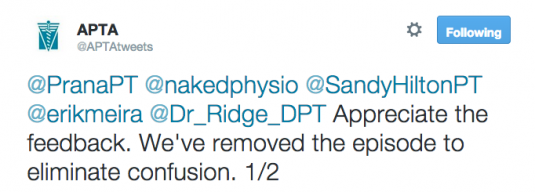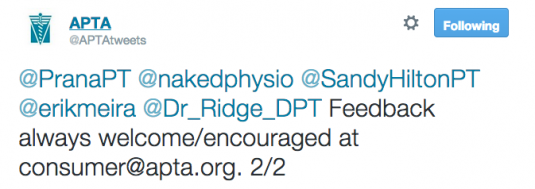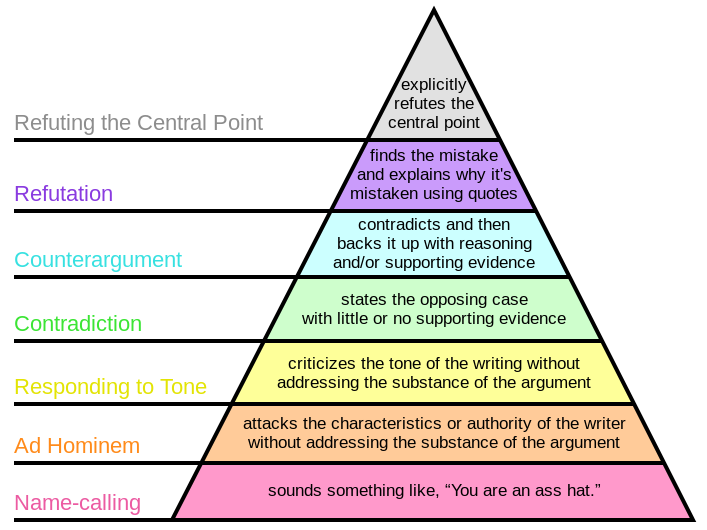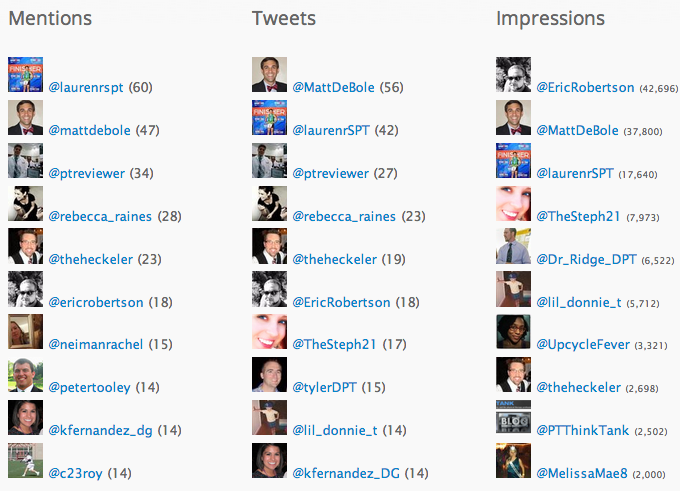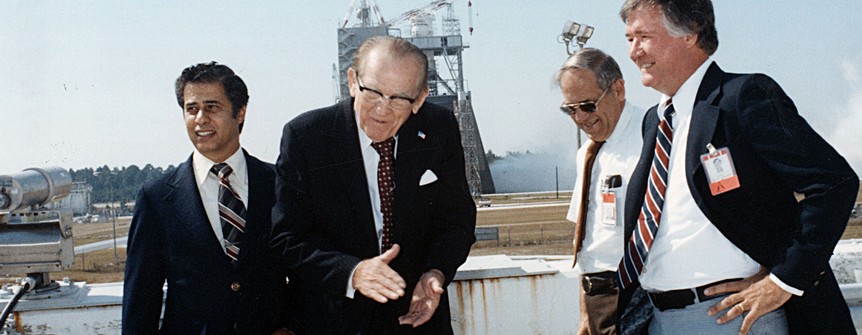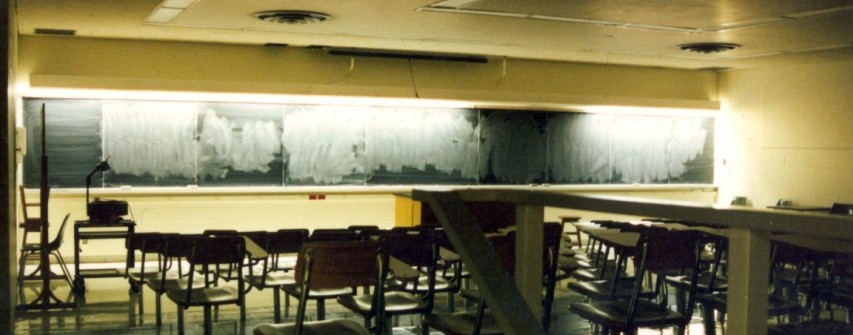The collective here at PTTT appreciate the insights, contributions, and struggles of the #DPTstudent. And thus, we present a new guest post by a current 3rd year #DPTstudent @GabeStreisfeld. Gabe is an eager, motivated student who connected with both Kyle and Eric at #APTAcsm. His insights are both thoughtful and valuable. We also owe him for attending our talks. So, enjoy the read…
——
Don’t worry, I am not about to argue why or why not the doctor of physical therapy is important, or whether or not we should market it. You can find that argument plenty of other places on the internet. Instead, I’d like to discuss the DPT education process from my perspective as a 3rd year doctor physical therapy student, and why I believe some students miss out on a huge aspect of it.
First let’s pave the way with google’s top answer to “definition of education”:
1) The process of receiving or giving systematic instruction, especially at school or university
2) an enlightening experience
Furthermore, when googling “definition of formal education”:
Formal education is classroom-based, provided by trained teachers. Informal education happens outside the classroom, in after-school programs, community-based organizations, museums, libraries, or at home.
I would argue that formal education is closely related to Google’s first definition as we know. It is the hours spent in class. It is the hours spent memorizing the origin, insertion, and innervation of every muscle of the body. It’s the practicals, competencies, OSCEs (objective structured clinical examinations), and paper tests. The logistics that pave the path between students and those 3 powerful letters: DPT. Formal education can absolutely harbor definition two; enlightening experiences. Although, I sense the busywork and exam-related stress can sometimes interfere with the more contemplative, reflective, and self-directed experiences that many would consider enlightening. Formal education is only one side of the coin, and although I cannot dispute its importance, my observation is most students focus too heavily on the formal only to neglect the potential power of the informal.
Informal education is where definition two takes the forefront. It is seeking those enlightening experiences outside of class. Getting involved with PT organizations at the school, community, and national level; pro bono and volunteer experiences; the conferences; lively social media debates, and self-driven PubMed searches. It is even the critical blogs and podcasts that continuously question and reframe. Informal education is not merely the knowledge gained, but the actual process of seeking that information. It is a unique, learned skill. Informal education allows the student to add her personal interests, inquiries, and discoveries to the DPT. It is where the student can evolve herself , nearly without restraint, to a higher level of critical thinking. You know the saying “it’s not the destination, it’s the journey.” However, why is some of the knowledge, skill, and insight gained outside the classroom unable, or unlikely, to occur in the formal education environment?
Obviously, informal education differs from formal education. There is no set end product. No exams for which to study, or degree to be obtained. This allows the student to focus on the process, present experience, and self paced exploration which can ultimately lead to that sense of enlightenment and profound self- discovery. I have observed formal education struggle to extract such concepts, because the end products of grades, degrees, and expectations often cloud the student’s view of the present experience. And, the narrow focus can also hinder a sense of the bigger picture.
However, investing in informal education pays dividends. It provides motivating power, allows intrinsic self-guidance, and hopefully facilitates the evaluation skills necessary to add perspective to a seemingly endless list of assignments and tests. This facilitates the ability to fully appreciate the intended processes and outcomes of formal education. It is imperative that students and professors alike recognize this connectedness between the informal and formal, because if nurtured properly, it will contribute to the experience and meaning of achieving a doctor of physical therapy degree.
The opportunities that lie within the realm of informal education are equally as important to the DPT program as the concrete curriculum. The doctorate is 3 years of classes, assignments, and exams; but it is also 3 years of potential time. Time to explore the profession we will all be entering; to view the profession, beautiful and ugly, from the inside before actually practicing. Time to map out and dip our feet into the numerous career pathways before embarking on our own professional journeys. 3 full YEARS of time to hone not only our professional skill set and knowledge base, but lay the foundation upon which we build our future careers.
Personally, I feel that informal education has contributed significantly to my personal and professional development during the pursuit of my DPT. It is where my professionalism thrives, and my critical thinking is tested and molded; where my thought processes and assumptions have been challenged. Informal education has only one rule: that you are motivated enough to direct yourself toward improvement. None of your professors can fully guide you in this experience, although they may attempt to initiate a spark through various structured experiences like reflection assignments, discussion boards, research assignments, and compiled portfolios. But, these are still well within the construct of the formalized education process. Potential barriers to informal education include time, resources, and support.
However, the vastness of this informal domain allows for a variety of successful approaches; you just have to be willing to explore the possibilities. It does not need to happen every day, or even every month. It requires no schedule. As long as you remain pro-active, inquisitive, and open minded, informal education will find its way to you, even if you don’t recognize it. This self-directed discovery, the auto-didacticism, prepares us to remain ever a student even after formal education has commenced. This is where I truly believe the title doctorate gains substance, otherwise what is it besides grades on a transcript?
Due to the self-directed nature of informal education, I cannot tell you where to explore. I personally find my informal education at national and state level conferences; by reading blogs, both scholarly and opinionated; following and entering twitter debates; listening to PT related podcasts; collecting, organizing, and disseminating research on topics that I find interesting; engaging classmates in philosophical PT discussions. Even writing a blog post. It does not matter how you conduct your informal curriculum because it is that: informal. The only advice I can give on making the most out of your 3 year doctorate education is the following:
Do not limit yourself to formal education.
Do not think everything you have to learn about being a physical therapist will be taught in school. It won’t.
Learn how to question what is being taught to you, and how to seek your own answers to those questions.
Learn how to ask the right questions.The profession has much to offer students who demonstrate interest, so take advantage. Informal education is what will make the difference in your education. It will help solidify the foundation of your career. It will give you the bigger picture of our profession, the one we, as DPT students, will soon be entering.
Finally, if you have been, or are planning on, spending your 3 years of PT school just getting through classes “B’s get degrees” style, by all means, you will obtain a DPT. But, then again, doctor is just a title. Remember, the piece of paper you receive on graduation day signifies merely the beginning of your journey, not the end.
——-
Gabe Streisfeld is a 3rd year DPT student attending Thomas Jefferson University in Philadelphia, PA. He is a life-long student of human movement both professionally through his physical therapy education and personally via a variety of physical pursuits including (but not limited to) powerlifting, hiking, parkour, and bouldering.
He’s always been intrigued by human movement and its capabilities. He believes in not overcomplicating the elegant and evolutionary simplicity of the human movement system. We are beings with the ability to adapt and grow in the presence of a stimulus. He yearns to use his knowledge and views on the human movement system to help others understand their capabilities and improve their physical function.
Follow him on twitter @GabeStreisfeld


